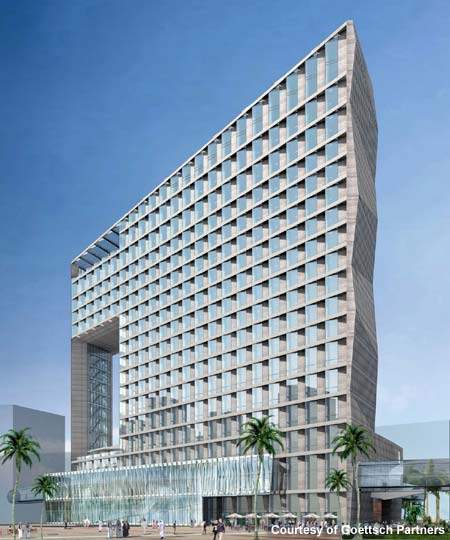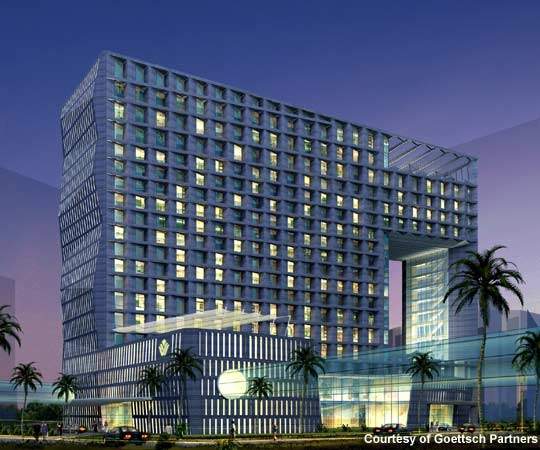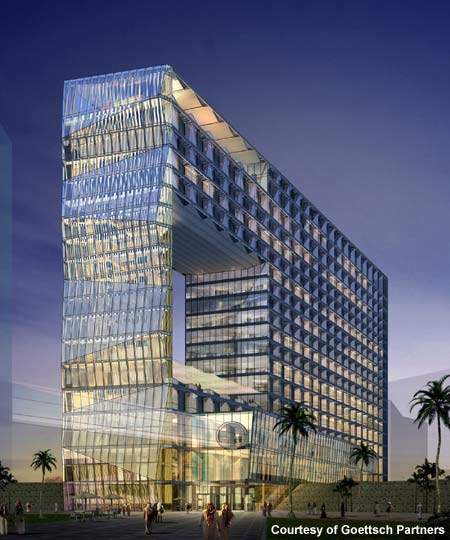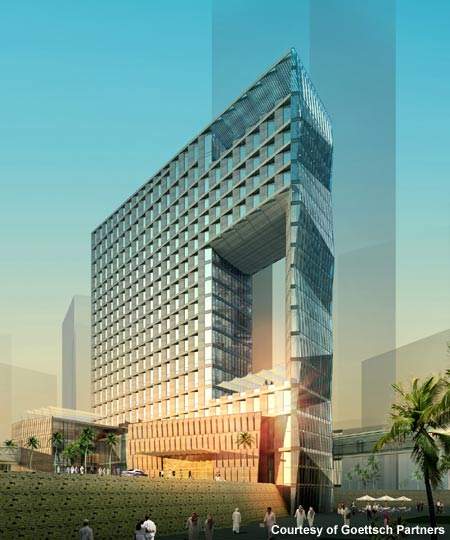Saudi Oger is a construction and project development company based in Riyadh, Saudi Arabia, that is building a new five-star hotel in the city’s King Abdullah Financial District. The company has commissioned Goettsch Partners, a Chicago-based architecture firm, to design the hotel.
Saudi Oger is also the contractor of the 214-key business hotel project, chosen by its project developer Rayadah Investment Company.
Hotel details
The project is sited on Parcel 1.08, one of the first ten parcels under development in the massive new master-planned district. The building will feature a 17-storey tower, a three-storey podium and a four-storey underground structure for hotel functions and parking.
On completion the hotel will house a large business centre, an executive club, signature restaurants, a lounge, a resort-style spa and a health club. The project will be operated as a Wyndham property.
Located on the east side of the upcoming district, the King Abdullah Financial District hotel sits adjacent to a wadi; a dry, man-made riverbed that organises the district’s developmental activities and provides the main pedestrian circulation and recreational promenade. To the west, the site faces a public square.
King Abdullah Financial District
Announced in 2006, the King Abdullah Financial District (KAFD) is a 400 acre area (1.6km²) north of central Riyadh that will include over 32 million square feet of development at full build-out.
Estimated at a cost of SAR28bn ($7.46bn), the district will be a key financial centre in the Middle East and is conceived as part of Riyadh’s overall economic diversification plan. The KAFD is designed to include premier office space, housing, a financial academy and recreational facilities.
The Saudi Public Pension Agency is the land owner and prime developer through its Rayadah Investment Company. Omrania & Associates, a local firm, is providing architectural and engineering advice on ten design-build parcels, including the hotel site.
Architect
Designed to attract more customers, the prism-shaped tower has a nine-storey opening. This open space separates programmatic functions and allows for views and light to penetrate the mass of the building. The podium structure houses the hotel’s amenities and conference facilities, and links the building to its surroundings at the pedestrian level. The podium incorporates a stretched multipurpose hall, restaurants, a spa, outdoor gardens and a rooftop terrace.
According to the KAFD master plan, each building façade facing the wadi must be faceted in its design, so the hotel’s slender north façade was given an undulating skin. Its south façade features a similar expression for consistency while giving the building a dynamic, ever-changing and vibrant appearance from each perspective.
The north façade is composed of a semi-transparent aluminium and glass curtain wall with two layers of ceramic frits that create a moiré effect. To optimise this effect, the pattern changes from a smaller pedestrian scale on the tower’s lower levels to a larger urban scale as it ascends the building’s full height.
The project architect has not only focused on the design, but also on climatic conditions. To mitigate extreme heat conditions throughout the year, the south façade will be mostly opaque, clad in stone with 150mm-wide, single-level slots that rhythmically alternate up the tower.
On the podium, these slots become windows to allow for select light and views. The north and south building façades will be lit at night to give the hotel a distinctive appearance and character within the larger development.
"The project incorporates many state-of-the-art sustainable strategies, including energy modelling, daylight control and solar shading,"
The tower’s long east and west façades feature a saw-toothed design with continuous slab edges. This pattern reveals the scale of the rooms while providing maximum shade from the extreme desert sun, while allowing measured light and views.
LEED certification
Designed to achieve LEED certification, the project incorporates many state-of-the-art sustainable strategies, including energy modelling, daylight control and solar shading, photovoltaic panels on the roof and proximity to alternative transportation systems within the KAFD.
As of December 2011, the $130m project is under construction and the majority of the schematic design is completed. The project will be completed by 2012.







